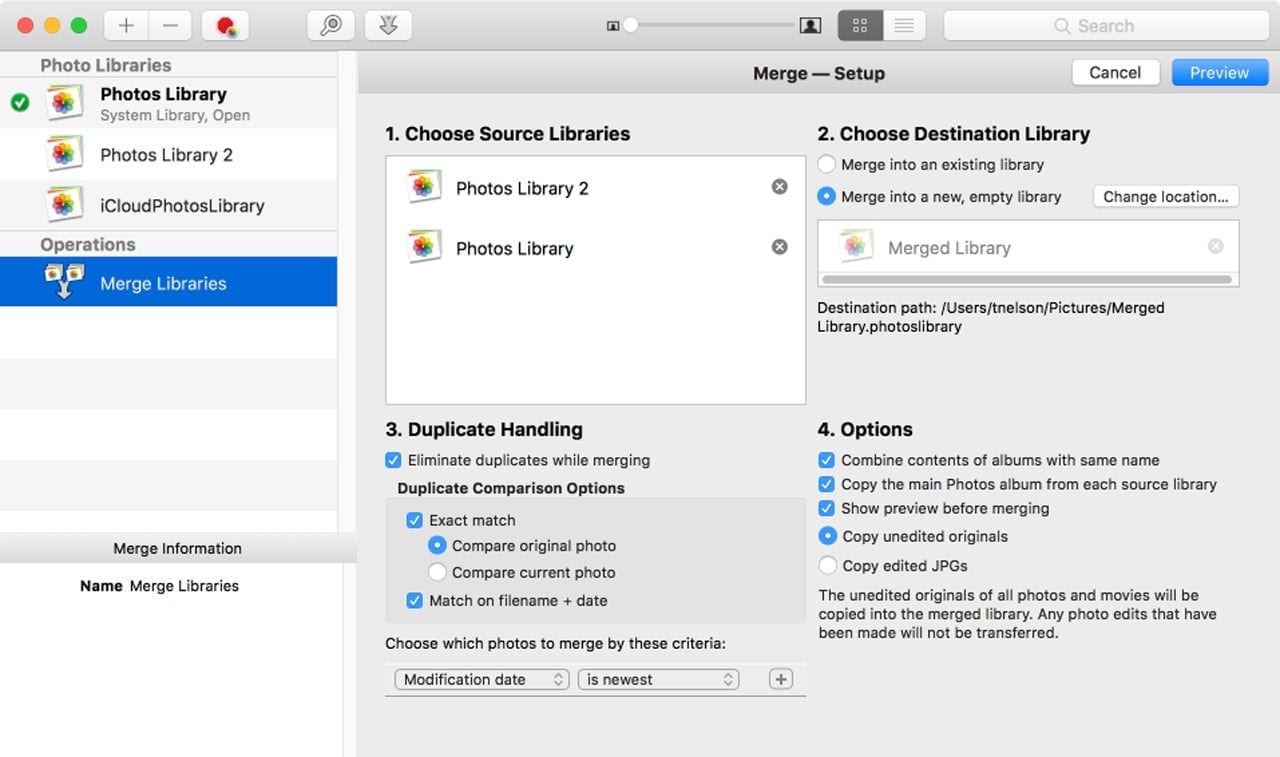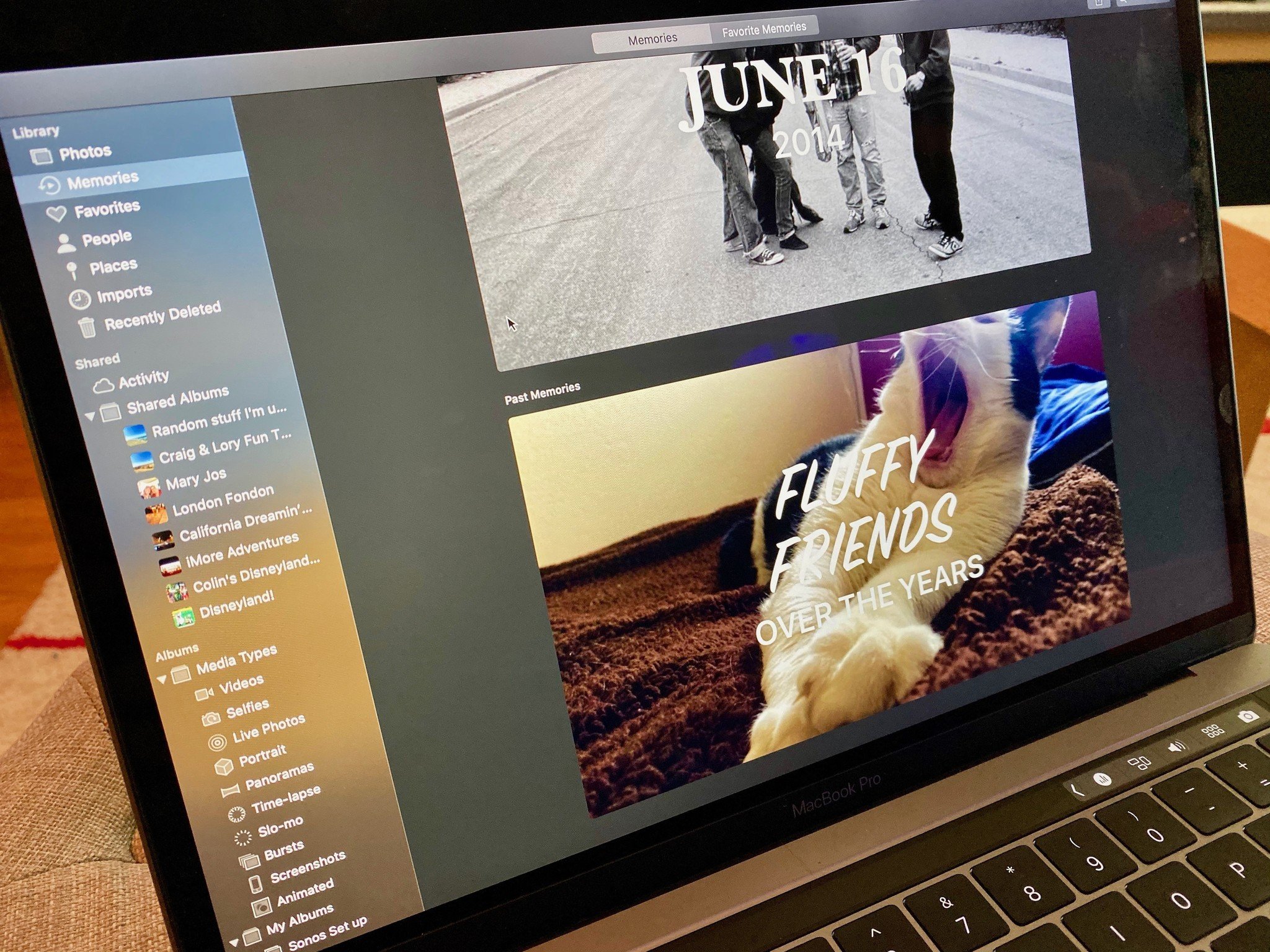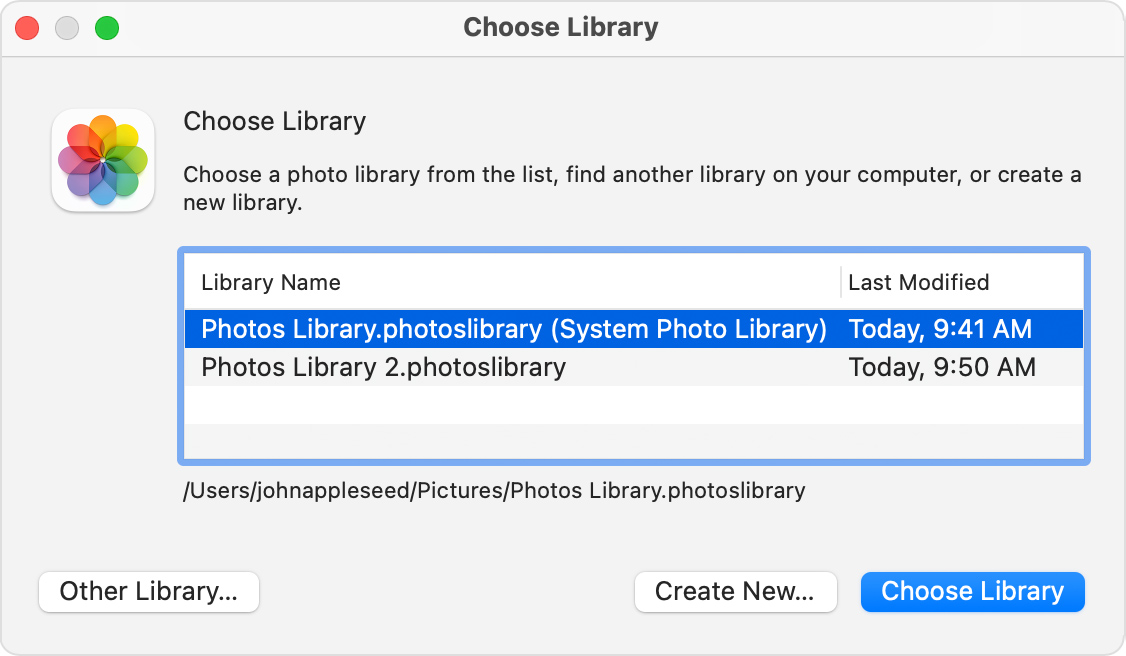- Step 2 (if you use iCloud): Turn off iCloud sync on your old library. Before you open your copied Photos library on the external drive, you have to disassociate the library on your Mac from iCloud. (If you don't use iCloud Photo Library, you can skip these steps.) Open Photos on your Mac. Go to the Photos menu. Select Preferences.
- Head over to the Photos app on your Mac, open the Library tab and click any photo. Press ⌘A to select them all. Hit backspace, then hit Return when asked if you're sure you want to delete them all.
While Photos for macOS lets you maintain multiple Photos libraries, only one library at a time can be designated the System Photo Library, and only the System Photo Library can sync with iCloud. To move our Photos Library, we drag it to its new location, double-click it, and the Photos app will now point to it. So, that was pretty easy. We’ll next show you how to create a completely new System Photo Library. Creating a New System Photo Library. There are any number of reasons you might want to create a new system library in Photos.
There’s little doubt that iPhoto is the most popular component of Apple’s iLife package. (Sorry iTunes, free downloads aren’t eligible.) By offering an easy-to-use way to view and organize digital photos, it’s become the shoe box of the digital-photo generation—for Mac users at least. But two significant criticisms of iPhoto are frequently heard: poor performance with large photo Libraries, and a lack of easy-to-use support for multiple Libraries (the latter perhaps a necessity due to the former).
Brian Webster’s iPhoto Library Manager 3.2.3 ( $20) offers solutions to both issues. By letting you split your photos into multiple iPhoto Libraries, you’ll see better performance. And by making it easy to work with those Libraries, it will make you actually want to use multiple Libraries. (To be fair to iPhoto, recent versions let you hold down the Option key at launch to choose a Library or create a new one, but iPhoto Library Manager is even easier to use and offers far more functionality…read on.)
When you first launch iPhoto Library Manager, it will display only your current iPhoto Library. If you already have multiple Libraries, click the Add Library button in the toolbar and then navigate to a Library to add it; repeat this process for each existing Library. (You can also drag-and-drop Libraries into the iPhoto Library Manager window.) This is a one-time process; once you’ve added your existing Libraries, they’ll always be listed. If you want to create a new Library, simply click the New Library button, give it a new name, and then choose where to save it (~/Pictures is the default location, but you can choose any location on your hard drive, an external drive, or even a network server).
You can then switch between Libraries by choosing a Library and clicking the Relaunch iPhoto button. iPhoto Library Manager will relaunch iPhoto using the chosen Library. You can also switch between iPhoto Libraries using iPhoto Library Manager’s Dock menu, which lists all of your Libraries, or by creating a Shortcut (via File: Create Shortcut or by dragging a Library from iPhoto Library Manager to the Finder), which creates an icon in the Finder for a particular Library; double-click that icon and iPhoto will launch using that Library. Whichever method you choose, iPhoto Library Manager puts the name of the current Library in iPhoto’s window title so you always know exactly which Library you’re currently using.
But basic Library-switching is just the tip of iPhoto Library Manager’s iceberg of functionality. When you select a Library in the list on the left, all albums and folders in that Library are listed in the middle column. (You can choose to view the album’s Rolls instead.) On the right are displayed the current location of the chosen Library, the version of iPhoto it’s currently compatible with, and its modification date. Click Calculate Size and iPhoto Library Manager will calculate the size of the Library (this is the size of the Library folder in the Finder).
By clicking the Options button, you get a number of options for setting permissions on the chosen iPhoto Library. This can be useful if you share a particular Library—one located outside of your user folder—with other users of your Mac; you can set up permissions so that other users can modify files in the Library.

iPhoto Library Manager also lets you move photos between Libraries. For example, if you want to move an album or a folder of albums from one Library to another, choose the source album on the left—so that its albums and folders are displayed—and then drag the desired album(s) or folder(s) from that Library to the desired Library. iPhoto Library Manager will switch iPhoto to the destination Library and then import the chosen album(s) or folder(s). What’s more, your albums maintain their organization, and your imported photos even retain their metadata—names, dates, ratings, and comments. (If you copy a Smart album from one Library to another, iPhoto Library Manager will create a standard album in the destination Library containing the photos present in the Smart album at the time of the copy.)
This ability to move albums and folders between Libraries means that you can use iPhoto Library Manager to manually merge multiple Libraries, or just parts of multiple Libraries, into a single Library or to split an existing Library into two smaller Libraries. (To accomplish the latter, you would create a new Library, transfer albums or folders to it, and then delete those albums or folders from the original Library. Unfortunately—or fortunately, depending on your point of view—you can’t delete photos from within iPhoto Library Manager; you need to switch to the desired album in iPhoto and then delete items from there.)
If you want to merge two or more complete Libraries into a single Library, iPhoto Library Manager’s Merge Libraries command lets you choose which Libraries to merge and into which Library they should be imported. For example, I knew that once my daughter was born, I was going to take a lot of pictures, so I started a new iPhoto Library just for her. But I eventually had many photos of her that also included other family members—photos I wanted in my “family” Library, as well. After a good number of sessions importing the same pictures into both Libraries, I decided I should just put all my family photos into a single Library. iPhoto Library Manager let me merge the two. (You can instead choose to create a new, empty, Library as the destination if you don’t want to modify an existing one.)
(If all this Library modifying makes you nervous, the File: Duplicate Library command creates a copy of an existing Library which you can then experiment with; the original will remain untouched.)
iPhoto Library Manager also has a number of advanced features that heavy users of iPhoto will appreciate. The Rebuild Library command can rebuild a corrupt or damaged Library based on the Library’s AlbumData.xml file. This can sometimes save a Library if you find that you it can no longer be opened in iPhoto. If even this doesn’t work, you can use the Extract Photos command to rescue photos from a chosen Library and place them in a new folder in the Finder. You lose all your albums and organization, but at least you have your photos—and using iPhoto Library Manager for this task is much easier than manually sifting through the Library folder in the Finder.
Another useful feature is the Import Photos command, which lets you import a folder of new photos directly into a particular Library without having to open that Library in iPhoto first; you can also accomplish the same result by dragging a folder of images onto the desired Library in iPhoto Library Manager’s window.
iPhoto Library Manager’s preferences dialog offers a plethora of options for determining how the application behaves, how photos and their metadata are copied, and how photos are imported.
Finally, if you’ve got a photo-capable iPod, iPhoto Library manager will let you consolidate photos from across multiple iPhoto Libraries into a single folder on your hard drive, which you can then—via iTunes—synchronize with your iPod. You just create a new iPod Folder and then designate which Libraries, or which albums or folders in each Library, you want synchronized to your iPod. Click Update and all the photos in the chosen collections will be copied to the folder, using the preferences you choose in the iPod Folders Options dialog. (One useful option here is Copy/Link To Thumbnails; since iTunes has to scale your photos down to display on your iPod, using this option makes the process much faster since the photos are already scaled down.) You can then choose this new folder—instead of a particular iPhoto album—in iTunes’ Photo sync preferences for your iPod.

iPhoto Library Manager’s Help system is excellent—something that can’t be said about many software titles—and provides some of the most detailed information around for learning about the structure of an iPhoto Library.
iPhoto Library Manager is a must-have utility for those who love iPhoto but whose photo collections have outgrown iPhoto’s practical capabilities.
iPhoto Library Manager requires Mac OS X 10.3.9 or later and is a Universal binary. It is compatible with all versions of iPhoto, although some features work only with iPhoto 4.0.3 or later.
Note: When you purchase something after clicking links in our articles, we may earn a small commission. Read ouraffiliate link policyfor more details.
- Related:
iCloud Photos lets you have your picture of a cake and shoot a video of eating it, too. You can create a library of images and movies that’s far larger than the storage space available on any linked iOS or macOS device without losing anything you’ve captured.
Apple accomplishes this by treating iCloud as the “truth.” It stores the original, high-resolution versions of your media in your iCloud storage, while providing the option to store only “optimized” or thumbnail versions that take up a fraction of the space on your Mac, iPhone, or iPad.
You can choose to download the full-scale originals, but you obviously need to have enough storage to hold the library.
If you don’t have an iOS device with the capacity or a Mac with a big enough internal or always-connected external drive, you have to rely entirely on Apple retaining the high-resolution originals. About 18 months ago, I wrote a column aptly titled, “Why you should not rely on iCloud Photo Library as your only media backup.” I meant it then and now.
The gist is that it’s risky to trust someone else, anyone else—even Apple—with the only backup of your stuff. Apple tends to encourage that these days with iCloud. And the company has been trustworthy with your data. But I still think we should always want and expect to have at least one—but typically multiple—complete copies of our important data in our possession or fully under our control.
Mac Photos How To Open Two Libraries Simultaneously Online
Is there a way to work around this? Not easily. Apple didn’t plan for this scenario. There’s no option at iCloud.com to “download all media from iCloud,” and iCloud as a service doesn’t offer an interface for third-party backup services, like Backblaze or Carbonite, to extract or regularly update such a backup, either.
While Photos for macOS lets you maintain multiple Photos libraries, only one library at a time can be designated the System Photo Library, and only the System Photo Library can sync with iCloud Photos.


The obvious solution would be to use an external drive to hold your Photos library. Apple makes it quite easy to move your library and point Photos to it, including syncing to iCloud Photos from that migrated library. (See “How to move an Apple Photos for OS X library to an external drive.” The column is from 2015, but the instructions remain accurate.)

However, that depends on that external volume being available whenever you want to access your Photos library. (And iCloud Photos sync requires the library be attached to a Mac to keep it up to date.)
The obvious idea would be to create a backup of the optimized library on an external drive that you connect from time to time to your Mac and set as the System Photo Library. Then you would seemingly just enable Download Originals to This Mac in Photos > Preferences > iCloud. When all the images and video have downloaded, you’d then swap back to your internal library, and make sure the iCloud setting was switched back to Optimize Mac Storage.
However, it’s inadvisable. While iCloud Photos should keep track of which media and metadata is the most recent—such as after you add titles and keywords to a bunch of photos or organize them into albums—because Photos and iCloud Photos isn’t designed to switch among libraries, it’s unclear what will happen. It’s a difficult thing to test, because you need to check over time, too, to see whether problems appear.
Whenever I’ve attempted to test this with a massive library I maintain, either by enabling and disabling iCloud Photos or switching between optimized and full-resolution settings, iCloud forces a full sync. Even with the high-speed connection I have, it can take from hours to days to complete, and I’m never quite sure whether the final state has changed from where it was before I swapped settings.
The answer ultimately lies with Apple, which could let iCloud Photos users designate multiple libraries (a la Time Machine), a backup library, or other strategies. For now, you either need to trust in Apple, switch to an external drive, or reduce the images you sync with iCloud Photos.
This Mac 911 article is in response to a question submitted by Macworld reader Jennifer.
Ask Mac 911
We’ve compiled a list of the questions we get asked most frequently along with answers and links to columns: read our super FAQ to see if your question is covered. If not, we’re always looking for new problems to solve! Email yours to mac911@macworld.com including screen captures as appropriate, and whether you want your full name used. Every question won’t be answered, we don’t reply to email, and we cannot provide direct troubleshooting advice.
Mac Photos How To Open Two Libraries Simultaneously Without
Note: When you purchase something after clicking links in our articles, we may earn a small commission. Read ouraffiliate link policyfor more details.
Mac Photos How To Open Two Libraries Simultaneously Free
- Related: